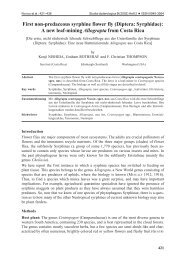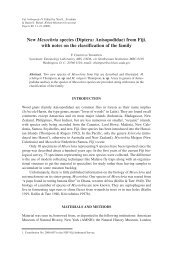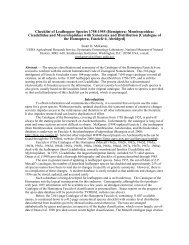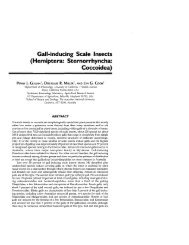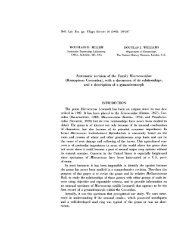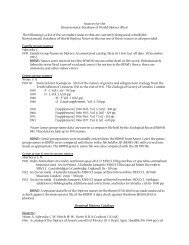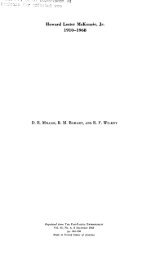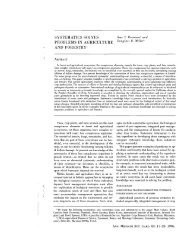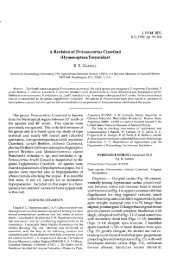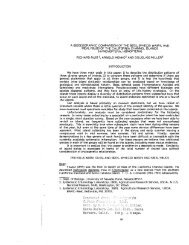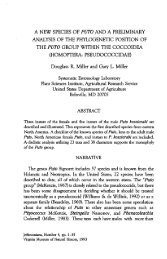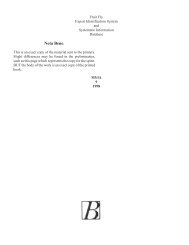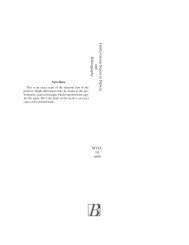Miller1971a - Systematic Entomology Laboratory
Miller1971a - Systematic Entomology Laboratory
Miller1971a - Systematic Entomology Laboratory
Create successful ePaper yourself
Turn your PDF publications into a flip-book with our unique Google optimized e-Paper software.
Reprinted from THE PAN·PACU'IC ENTOMOLOGIST<br />
Vol. 47, October, 1971, No.4<br />
pp. 293-303<br />
Made in United States of America<br />
Mealybugs of Santa Cruz Island, California!<br />
(Homoptera: Coccoidea: Pseudococcidae)<br />
DOUGLASS R. MILLER<br />
<strong>Systematic</strong> <strong>Entomology</strong> <strong>Laboratory</strong>, Agricultural Research Service,<br />
U. S. Department of Agriculture, Washington, D. C. 20250<br />
The purpose of this paper is to discuss the mealybugs of Santa Cruz<br />
Island. By examining the distribution patterns of mainland pseudococcids<br />
and by reviewing studies of other parts of the California insular<br />
biota, it has been possible to locate likely sources of the Santa Cruz<br />
Island mealybug fauna.<br />
There are 16 major islands along the Baja California-southern California<br />
coast which are normally called the California Islands; these<br />
islands are divided into three groups. Those off the coast of Baja California<br />
are the Baja California Islands, those off the coast of California<br />
1 National Science Foundation Grant No. GB·5847 to the late Mr. Howard L. McKenzie, University of<br />
California, Davis, provided funds which aided in the completion of the paper.<br />
THE PAN-PACIFIC ENTOMOLOGIST 47: 293-303. October 1971<br />
c.ii'icial use
294 THE PAN-PACIFIC ENTOMOLOGIST [VOL. 47, No.4<br />
from Point Conception to San Diego are the Southern Channel Islands,<br />
and those off the coast near the town of Oxnard are the Northern Channel<br />
Islands. The Northern and Southern Channel Islands are collectively<br />
called the Southern California Islands (Philbrick, 1967).<br />
This paper is primarily concerned with the Northern Channel Islands.<br />
From east to west the four islands comprising this group are: Anacapa,<br />
with three islets, Santa Cruz, Santa Rosa, and San Miguel.<br />
THE CALIFORNIA ISLAND BIOTA<br />
The fauna and flora of the Northern Channel Islands is basically the<br />
same as that of the adjacent mainland; however, there are several notable<br />
exceptions. First, there is a surprisingly large number of endemics considering<br />
that the islands have been separated from the mainland only<br />
since the mid-Pleistocene (Valentine and Lipps, 1967; Axelrod, 1967)<br />
and are presently only 13 miles from the nearest point on the mainland<br />
(Philbrick, 1967). Second, components of the Northern Channel Island<br />
biota show striking affinities with biotas either far to the north or to the<br />
south on the mainland.<br />
Although the percent of endemism on the California Islands is relatively<br />
low, endemic forms are known throughout most of the carefully<br />
studied groups of plants and animals. Among scientists there is disagreement<br />
regarding the source of this endemism. Some believe that the<br />
endemics have evolved on the islands themselves, while others think that<br />
the islands, with their moderate climates, are relictual areas of previously<br />
more widely dispersed species. It is now apparent that the majority of<br />
the endemics are of relictual origin. Axelrod (1967) pointed out that<br />
in the past most of the woody endemics occurred rather extensively on<br />
the mainland. However, there are still a few examples of endemics which<br />
are not easily explained by the refugia concept. The divergent forms of<br />
the tarweed genus Hemizonia (Carlquist, 1965) and the concentration<br />
of dwarf and giant endemics on the islands, appear to be examples of<br />
divergent endemism. It is likely therefore that both sources of endemism<br />
have added to the California insular biota with relictual endemism being<br />
the more predominant type.<br />
Disjunct distribution patterns are also of interest. A number of the<br />
California insular vascular plants are distributed on the mainland in<br />
areas which are not adjacent to the islands where they occur (Raven,<br />
1967). On the Northern Channel Islands these affinities are mainly<br />
with biotas which occur at least 100 miles to the north. A few cases of<br />
affinities to the south are also known.<br />
The presence of northern and southern components within the extant
OCTOBER 1971] MILLER-SCI MEALYBUGS 295<br />
flora of a single island has been best explained by Axelrod (1967). He<br />
believes that during the last glacial period the flora of the coastal areas<br />
of southern California was most similar to the present flora of Monterey,<br />
approximately 200 miles to the north of Santa Cruz Island. A warming<br />
trend, called the Xerothermic period, followed this glaciation and allowed<br />
a more arid flora to become predominant. The previous flora receded<br />
northward leaving only remnant populations in localized pockets which<br />
remained favorable. The more moderate and moist climates of the<br />
islands apparently favored these remnants. Approximately 5,000 years<br />
later the climate gradually became more moist and the Xerothermic<br />
period ended. The arid flora was pushed southward and inland leaving<br />
remnants along the coast and on the islands. Therefore the present insular<br />
biotas possess components which are allied to both northern and<br />
southern mainland elements.<br />
SANTA CRUZ ISLAND<br />
From a zoogeographical standpoint, Santa Cruz is probably the most<br />
interesting of the Northern Channel Islands. Of the four islands comprising<br />
this group, Santa Cruz is the largest in land area (Philbrick,<br />
1967), has apparently been land-positive for the longest period of time<br />
(Weaver and Doerner, 1967), and probably has the greatest potential<br />
for ecological diversity (i.e., diversity in soil type, climate, and elevation).<br />
For these reasons the biota of Santa Cruz is most likely to give<br />
clues to the past history of the Northern Channel Islands.<br />
Santa Cruz Island is diverse ecologically. Most of its shoreline is<br />
made up of steep cliffs, but stream beds which dissect the coastline<br />
frequently support small coastal beaches of sand or smooth, surf worn<br />
rocks, or of both. Larger beaches are also present, particularly on the<br />
southwest end of the island. Deep canyons and rugged hillsides are the<br />
predominant surface features; the highest peak is over 2,400 feet. The<br />
center of the island supports a linear series of wide valleys formed on a<br />
fault which runs along the east-west axis of the island. It is this series of<br />
valleys which adds to the diversity of Santa Cruz. Frequently when the<br />
coastal areas are windy or covered with fog, the central valley is clear and<br />
nearly wind free. Thus, the inland areas are climatically quite different<br />
from the coast. The rapid changes in habitats which one experiences on<br />
the island are startling. Within its confines I traveled to dense oak<br />
groves, open grasslands, pine forests, cactus laden hillsides, dense chaparral<br />
areas, barren ridges, wind blown beaches, protected lagoons, steep<br />
canyons, open valleys, shingle beaches, permanent freshwater streams,<br />
and coastal cliffs.
MAP 1. Santa Cruz Island mealybug collection sites. ,f'.<br />
l-..:l<br />
~<br />
..,<br />
~<br />
l>:<br />
~<br />
~<br />
("')<br />
::;;<br />
c::;<br />
i:'j<br />
~..,<br />
,f'.<br />
~--l<br />
~<br />
o<br />
SANTA CRUZ ISL.<br />
CALIF.<br />
o<br />
is:<br />
1 BEACH 'WEST OF WATER CANYON 10 NORTH RIM SOUTH OF PELICAN BAY o<br />
2 CANADA DE LA LAGUNA 11 PASTURE EAST OF WEST POINT<br />
N<br />
8<br />
3 CANADA DEL MEDIO (U.C. RFSEARCH STATION) 12 PORTEZULA 8<br />
[I)<br />
4 CHRISTI BEACH 13 PRISONERS HAROOR 1 ..,<br />
5 CLIFFS SOUTH OF CHRISTI BEACH 14 SOUTH RIM EAST OF U.C. RESEARCH STATION 0/.2<br />
'--;n;.~<br />
6 COCHES PRIETOS 15 SOUTH RIM WEST OF U.C. RESEARCH STATION<br />
7 FRASER POINT 16 WATER CANYON<br />
:;<br />
8 JOHNSTON CANYON 17 WEST POINT I s o<br />
9 LA CUESTA. 18 UPPER CANADA DEL PUERTO<br />
r<br />
PDSISl159
OCTOBER 1971]<br />
MILLER-SCI MEALYBUGS<br />
297<br />
The insect fauna of Santa Cruz Island, until recently, has been poorly<br />
known. Dr. Carey Stanton, present owner of most of the island, has<br />
encouraged scientific studies on Santa Cruz and has allowed the University<br />
of California to establish a research station for this purpose. Given<br />
this opportunity, entomologists from the Berkeley, Davis, and Riverside<br />
campuses have undertaken survey expeditions. I have been fortunate to<br />
participate in three trips, and although this paper must he considered<br />
preliminary, it probably includes a majority of the mealybug species<br />
which occur on the island.<br />
SCALE INSECTS AND PLANTS<br />
There are some notable similarities between the habits of scale insects<br />
(Coccoidea) and plants in regard to dispersibility. Female scales are<br />
generally sedentary. The eggs are normally covered either by the body<br />
of the female or by a waxy secretion produced by her. First instar<br />
nymphs of both sexes are mobile, and although they are susceptible to<br />
long-range wind movements, they are probably best adapted for shortrange<br />
dispersal to other parts of the parent plant or to adjacent plants.<br />
Once the first instar has settled, further movements are either nonexistent<br />
or quite unusual. With the exception of the first instar, the<br />
immature stages of the male are relatively sessile; movements in search<br />
of pupation sites may take place, but these are apparently very limited.<br />
The adult male is usually winged and apparently is adapted to long-range<br />
as well as short-range movements; it may carry genetic material to geographically<br />
isolated populations, but it cannot establish a new population.<br />
Movements of adult males are both active and passive. The presence of<br />
female sex pheromones (Tashiro and Chambers, 1967) would seem to<br />
confirm active movements of the male toward the female. Passive dispersal<br />
has not been conclusively established, but the presence of long<br />
caudal projections and a light body weight appear to be adaptations to<br />
enhance bouyancy for passive wind dispersal.<br />
Plants have many of these characteristics. The primary portion of<br />
most plants with the attached female reproductive system is sessile. Seeds<br />
usually are enclosed within other plant tissues. Although some seeds are<br />
capable of long-range passive dispersal, establishment in many instances<br />
occurs in areas adjacent to the parent plant; once established, movements<br />
are unlikely. Pollen can carry genetic material to geographically isolated<br />
populations, but it is not capable of establishing a new colony. The use<br />
of pollinators which actively seek out receptive reproductive parts in<br />
plants would seem to qualify as a type of active dispersal, whereas movements<br />
of pollen by wind clearly fit passive dispersal.
298 THE PAN-PACIFIC ENTOMOLOGIST [VOL. 47, No.4<br />
The similarities between plants and scale insects, though perhaps somewhat<br />
superficial, have encouraged me to search for correlation between<br />
the Santa Cruz Island flora and the scale insect fauna. On this island<br />
Raven (1967) records 31 endemic plants, including seven which are<br />
exclusively endemic and 24 which are present on Santa Cruz and at least<br />
one other California Island. Plants with disjunct distribution patterns<br />
and plants with restricted mainland populations are also present on Santa<br />
Cruz. Therefore, I had hoped to find these same characteristics within<br />
the scale insect fauna.<br />
SANTA CRUZ ISLAND MEALYBUGS<br />
I have restricted my attention to mealybugs because this group is the<br />
best known of the California scale insects, and because insular pseudococcids,<br />
of all the Coccidea, are normally the most distinctive.<br />
The following list of the mealybugs known to occur on Santa Cruz<br />
Island includes 13 genera and 23 species. The localities may be found<br />
on the accompanying map. Plant names are presented as listed by Munz<br />
and Keck (1965).<br />
Amonostherium<br />
lichtensioides (Cockerell)<br />
1. Coches Prietos, 18 June 1967, Artemisia cali/ornica (crown and foliage)<br />
2. south rim east of U. C. Research Station, 9 May 1968, A. cali/ornica (foliage)<br />
Anisococcus<br />
quercus IEhrhorn)<br />
1. upper Canada del Puerto, 27 April 1969, Quercus agri/olia (under bark and<br />
in duff beneath tree)<br />
Chorizococcus<br />
abroniae McKenzie<br />
1. Christi Beach, 19 June 1967, Amblyopappus pusillus, Franseria chamissonis,<br />
Mesembryanthemum crystallinum (roots)<br />
Discococcus<br />
simplex Ferris<br />
1. pasture east of West Point, 30 April 1%9, Sitanion sp. (crown)<br />
spectabilis McKenzie<br />
1. Prisoners Harbor, 7 May 1968, Bromus sp. (roots)<br />
Distichlicoccus<br />
salinus (Cockerell)<br />
1. Canada de la Laguna, 30 April 1969, Distichlis spicata (leaf blade sheath)<br />
2. Christi Beach, 5 May 1968 and 26 April 1969, D. spicata (on leaf blade)<br />
3. mouth of Johnston Canyon, 21 June 1967, D. spicata (leaf blade sheath)<br />
Heterococcus<br />
arenae Ferris<br />
1. Canada del Medio, U. C. Research Station, 16 June 1967, Festuca sp. (leaf<br />
blade sheath)
OCTOBER 1971] MILLER-SCI MEALYBUGS 299<br />
2. Cascada, 4 May 1968, grass (leaf blade sheath)<br />
3. Coches Prietos, 18 June 1967, Festuca sp. (leaf blade sheath)<br />
4. south rim west of U. C. Research Station, 6 May 1968, grass (leaf blade<br />
sheath)<br />
Paludicoccus<br />
distichlium (Kuwana)<br />
1. Christi Beach, 5 May 1968, Distichlis spicata (crown)<br />
Phenacoccus<br />
colemani Ehrhorn<br />
1. north rim south of Pelican Bay, 3 May 1969, Garrya sp. (undersides of<br />
leaves)<br />
eriogoni Ferris<br />
1. Prisoners Harbor, 7 May 1968, Eriogonum lati/olium (stems)<br />
eschscholtziae McKenzie<br />
1. Fraser Point, 11 May 1968, Haplopappus venetus (roots)<br />
gossypii (Townsend and Cockerell)<br />
1. Canada del Medio, U. C. Research Station, 17 June 1967, Eschscholtzia<br />
cali/ornica (crown and roots)<br />
solani Ferris<br />
1. Fraser Point, 11 May 1968, Mesembryanthemum nodi/lorum (roots)<br />
Pseudococcus<br />
beardsleyi Miller and McKenzie<br />
1. north rim south of Pelican Bay, 3 May 1969, Arctostaphylos subcordata<br />
(foliage)<br />
2. south rim west of U. C. Research Station, 18 June 1967, A. subcordata<br />
(foliage)<br />
longisetosus Ferris<br />
1. Canada del Medio, U. C. Research Station, 7 May 1968, Rhus diversiloba<br />
(roots)<br />
obscurus Essig<br />
1. cliffs south of Christi Beach, 26 April 1969, Castilleja sp. (crown)<br />
2. La Cuesta, 5 May 1968, Eriogonum lati/olium grande (crown)<br />
Puto<br />
yuccae (Coquillett)<br />
1. beach west of Water Canyon outlet, 2 May 1969, Eriogonum sp. (roots)<br />
2. Christi Beach, 19 June 1967, 5 March 1968, and 5 May 1968, Amblyopappus<br />
pusillus, Atriplex semibaccata, Chenopodium sp., Eriogonum sp., and Haplopappus<br />
venetus (roots, crown, and foliage)<br />
3. Portezuela, 20 June 1967, soil<br />
4. Water canyon (500 ft.), 17 June 1967, Diplacus longi/lorus and Zauschneria<br />
cana (foliage)<br />
Rhizoecus<br />
bicirculus McKenzie<br />
1. south rim east of U. C. Research Station, 9 May 1968, grass (roots)<br />
2. south rim west of U. C. Research Station, 6 May 1968, Lotus scoparius<br />
(roots)<br />
gracilis McKenzie
300 THE PAN-PACIFIC ENTOMOLOGIST [VOL. 47, No.4<br />
1. Coches Prietos, 18 June 1967 and 10 May 1968, Artemisia cali/ornica and<br />
Haplopappus canus (roots)<br />
leucosomus (Cockerell)<br />
1. Coches Prietos, 10 May 1968, Dudleya greenei (roots)<br />
Spilococcus<br />
kei/eri McKenzie<br />
1. beach west of Water Canyon outlet, 2 May 1969, Eriogonum sp. (roots)<br />
Trionymus<br />
caricis McConnell<br />
1. Christi Beach, 26 April 1969, Distichlis spicata (leaf blade sheath).<br />
utahensis (Cockerell)<br />
1. Canada de la Laguna, 30 April 1969, Bromus sp. (leaf blade sheath)<br />
2. mouth of Johnston Canyon, 21 June 1967, Avena sp. (leaf blade sheath)<br />
There appears to be an unusually small number of pseudococcids on<br />
Santa Cruz Island. This is difficult to quantify, but as an indication,<br />
when collecting in the coastal areas of southern California, it is exceedingly<br />
unusual to find less than ten lots of mealybugs per day whereas, on<br />
the island I was never able to find more than four. In addition, Mc<br />
Kenzie (1967) lists approximately 53 species of mealybugs which<br />
probably occur in the coastal areas near Oxnard and which have been<br />
collected on hosts that occur on Santa Cruz Island. Of these 53 species,<br />
only 23 are known to occur on Santa Cruz. Therefore, not only are there<br />
a small number of mealybug species on Santa Cruz, but these species<br />
appear to be sparsely distributed.<br />
All mealybugs that ocur on Santa Cruz Island have been recorded<br />
from the California mainland. Nine of the 23 species present on the<br />
island are distributed throughout most of continental California, five of<br />
the 23 species occur exclusively in the coastal mountain ranges, two<br />
occur in the coastal ranges and the southern California deserts, two in<br />
the coastal ranges and the beaches, one in the coastal ranges and the<br />
Cascade Mountains, one exclusively on beaches, one in the Trinity Alps,<br />
and two occur in the saline regions along the coast. These data suggest<br />
that the majority of the mealybugs which occur on Santa Cruz Island<br />
are most closely allied to the aggregation of pseudococcids which are<br />
present in coastal areas on the mainland. The presence of a small number<br />
of desert and northern mountain species suggest the displacement of<br />
previous northern and southern mealybug faunas. These data are consistent<br />
with the findings of botanists.<br />
Although mealybug collecting on Santa Cruz has not been extensive<br />
enough to give detailed distribution patterns, it appears that the pseudococcids<br />
show no unusual ecological diversity. As far as can be determined,<br />
none of the species occur on hosts or in habitats whch are radically dif
OCTOBER 1971]<br />
MILLER-SCI MEALYBUGS<br />
301<br />
ferent (Le., species which occur on mainland beaches occur on island<br />
beaches) .<br />
Perhaps the most interesting aspect of the Santa Cruz Island mealybug<br />
fauna is found among the species which show disjunct distribution<br />
patterns. They are as follows:<br />
Southernmost<br />
Approximate<br />
mainland<br />
distance north<br />
Mealybug locality from Oxnard<br />
A nisococcus quercus Mountain View, 275 miles<br />
Santa Clara Co.<br />
Discococcus simplex San Miguel, 135<br />
San Luis Obispo Co.<br />
Pseudococcus longisetosus Pacific Grove, 225<br />
Monterey Co.<br />
Rhizoecus bicirculus Weaverville, 480<br />
Trinity Co.<br />
Trionymus caricis Patterson, 250<br />
Stanislaus Co.<br />
Although only five pseudococcids show this pattern, it is significant that<br />
they are all northern disjunctions. This is consistent with the findings<br />
of Raven (1967) and Axelrod (1967), who indicate that the majority<br />
of the non-endemic Northern Channel Island plants which are not present<br />
on the adjacent mainland are present in northern California.<br />
Pseudococcus beardsleyi, also shows an interesting distribution pattern,<br />
occurring in several small areas in the higher elevations of Santa<br />
Cruz Island and in similar areas at Pt. Reyes, Mt. Tamalpais, and Mt.<br />
Wilson on the mainland. The occurrence of this species in small, widely<br />
separated areas is reminiscent of the restricted distribution patterns of<br />
many plant relicts. It seems significant that Pt. Reyes, Mt. Tamalpais,<br />
and the upper elevations of Santa Cruz Island are inhabited by a number<br />
of these relicts and, in fact, could be considered refugia. Therefore, if<br />
P. beardsleyi is a relict pseudococcid, careful collecting in these refugia<br />
might reveal other interesting mealybug species.<br />
SUMMARY<br />
There are 13 genera and 23 species of mealybugs known on Santa Cruz<br />
Island none of which are endemic. The pseudococcid fauna of the island<br />
is a depauperate aggregation of species most like the mealybugs of the<br />
adjacent mainland, with a small representation of northern species. The<br />
majority of the Santa Cruz Island mealybugs have been previously re
302 THE PAN-PACIFIC ENTOMOLOGIST [VOL. 47, No.4<br />
corded from the beaches or coastal mountain ranges on the California<br />
mainland.<br />
There are both differences and similarities between the flora and the<br />
mealybug fauna of Santa Cruz Island. The most striking difference is the<br />
absence of endemic pseudococcids. It is possible that when the more<br />
distant Northern Channel Islands are examined, endemic forms will be<br />
discovered. Similarities are numerous. Both the flora and the mealybug<br />
fauna show close affinities to their respective counterparts on the adjacent<br />
mainland, both possess species with disjunct and restricted mainland<br />
distribution patterns, and both possess small components of northern<br />
and southern biotas.<br />
ACKNOWLEDGMENTS<br />
I gratefully acknowledge the assistance of Mr. Michael R. Benedict,<br />
Channel Island Field Station, University of California, not only for<br />
transporting me to the diverse areas of the island, but also for identifying<br />
most of the plant hosts.<br />
Thanks are also due to Dr. Carey Stanton, owner of most of Santa Cruz<br />
Island, for permtting me to collect on his property. His encouragement<br />
of scientific studies on the island is commendable.<br />
Mr. Robert O. Schuster, University of CalHornia, Davis, made available<br />
a copy of the map used in this paper and reviewed the manuscript.<br />
Mr. Michael R. Benedict, Dr. Albert A. Grigarick, Dr. Donald S. Horning,<br />
Jr., Dr. Arnold S. Menke, Mr. Richard W. Rusi, and Mr. Robert O.<br />
Schuster all collected specimens utilized in this study.<br />
LITERATURE CITED<br />
AXELROD, D. I. 1967. Geologic history of the Californian insular flora. Pp. 267<br />
314 in R. N. Philbrick (ed.), Proceedings of the Symposium on the<br />
Biology of the California Islands. Santa Barbara Bot. Gard., Calif.,<br />
341 pp.<br />
CARLQUIST, S. 1965. Island Life, a Natural History of the Islands of the World.<br />
Natur. Hist. Press, Garden City, New York, 451 pp.<br />
McKENZIE, H. L. 1967. Mealybugs of California with taxonomy, biology and con<br />
trol of North American species. Univ. Calif. Press, Berkeley, 525 pp.<br />
MUNZ, P. A. AND D. D. KECK. 1965. A California Flora. Univ. Calif. Press,<br />
Berkeley, 1681 pp.<br />
PHILBRICK, R. N. 1967. Introduction. Pp. 3-8 in R. N. Philbrick (ed.). (For<br />
complete citation see Axelrod.)<br />
RAVEN, P. H. 1967. The floristics of the California Islands. Pp. 57-67 in R. N.<br />
Philbrick (ed.). (For complete citation see Axelrod.)<br />
TASHIRO, H. AND D. L. CHAMBERS. 1967. Reproduction in the California red<br />
scale, Aonidiella aurantii. I. Discovery and extraction of a female sex<br />
pheromone. Ann. Entomol. Soc. Amer., 60(6}: 1166--70.
OCTOBER 1971] MILLER-SCI MEALYBUGS 303<br />
VALENTINE, J. W. AND J. H. LIPPS. 1967. Late Cenozoic history of the southern<br />
California Islands. Pp. 21-35 in R. N. Philbrick (ed). (For complete<br />
citation see Axelrod.)<br />
WEAVER, D. W. AND D. P. DOERNER. 1967. Western Anacapa-a summary of the<br />
Cenozoic history of the Northern Channel Islands. Pp. 13-20 in R. N.<br />
Philbrick (ed.). (For complete citation see Axelrod.)



